3 min read
Why Purchasing and Finance should use cross-departmental KPIs for spend under management
Jeroen Rozeboom, Digital Transformation Specialist
14-Apr-2022 22:20:52

In corporate organizations, the Procurement and Finance departments have traditionally been separated; in fact, they regularly reside in other branches of the company. This need not be a problem as long as there is sufficient alignment on processes that touch the functions of Purchasing and Finance. To what extent is this the case in your organization?
In my experience, this does not happen enough. Working in such silos leaves opportunities unexploited. Consider an important issue like spend under management. Increasing spend under management only succeeds when both departments work better with each other.
Product related spend vs. non product related spend
Spend under management refers to an organization's annual addressable expenditures. These are expenditures where an organization uses preferred suppliers. This coincides with Procurement's responsibility for spend management and supplier management.
Here Procurement focuses on getting timely access to supplier products or services at the most favorable terms with the least possible risk. The greater the proportion of this spending that is under the control of Purchasing and/or Finance, the more predictable the spending becomes.
💡LEESTIP: How the Kraljic matrix improves your supplier management and procurement process
To what extent is this already the case for your organization? It is good to distinguish here between product related spend (direct procurement) and non-product related spend (indirect procurement).
Take, for example, the purchasing department of an automobile manufacturer. Top priority for their purchasing process is to maintain the quantity and quality of all inventory to "keep the assembly line running. Most likely, a purchaser has contracted for a variety of different parts with a preferred supplier who supplies the essential products to manufacture the car. These product-related costs are direct expenses that are readily predictable to Finance.
Non-product related spend - including office supplies or ICT products to support staff - is probably less important in Procurement's procurement strategy. As a result, those expenditures are usually not handled according to clear and centrally established agreements. This can lead to maverick buying.
Costly time commitment Finance
Purchasing, busy every day with product-related spend, often fails to see the importance of getting non-product-related spend under control. Surely it is not possible to save that much on a supplier from whom an organization purchases only a few thousand euros per year? Surely it is not profitable to select preferred suppliers for such small amounts? That is a misconception.
Finance sees invoices coming in daily from unfamiliar suppliers that still need to be checked and entered first as part of auditability. And the time it takes to create a creditor, get an invoice audited and approved, and finally process it financially, suddenly makes a quick deal to buy ten laptops from a random supplier a lot less interesting.
Assuming thousands of these types of invoices per year, Finance is dealing with a considerable and especially costly time commitment. Not surprisingly, getting this non-product related spend under control is a long-held desire.
READ ALSO: Maverick buying gives Finance in particular a headache
Cross-departmental KPIs spend management
Because spend management is vested in Procurement, Finance is largely dependent on Procurement to see that desire fulfilled. However, as long as the importance is mostly not recognized by Purchasing and only product-related spend is prioritized, not much will change.
And that's a shame, because the savings potential is very interesting. Let's assume that if an average corporate organization has 100 million euros of spend per year, 20 million euros of that 100 million euros is non-product related spend. By bringing this spend under management as well, a cost advantage of 10% and thus 2 million euros can easily be achieved.
It comes down to an organization's willingness to change. Finance will have to agree at the board level to implement cross-departmental KPIs for managed spend.
KPIs that require Finance and Purchasing to work together on a solution to better manage spend and scrutinize their purchase-to-pay process.
For example, a maximum percentage of unmanaged spend per year. This is where purchase-to-pay automation software, to capture each step from purchase to payment compliantly, can help. This provides more spend visibility and also helps reduce the longtail to suppliers.
The importance of change management
The requirement to work with a purchase portal does represent a culture change for many organizations. To guide employees from Purchasing and Finance in this new way of working, change management is crucial.
It is advisable to appoint an (external) change manager to manage the process changes and monitor the interests of both Procurement and Finance.
In practice, it will no longer be possible to just call that friendly supplier for a quick order. But what weighs more heavily for your organization? The quick convenience for the employee or a savings potential of 2 million euros per year?
If you would like to exchange thoughts on streamlining the purchase to pay process, feel free to contact me.









